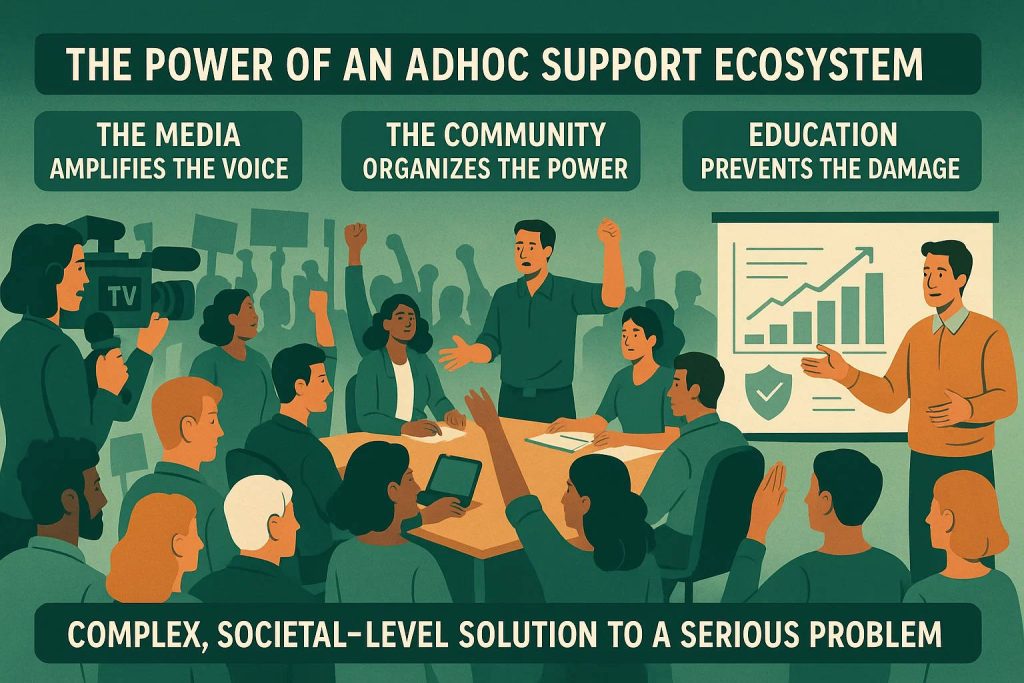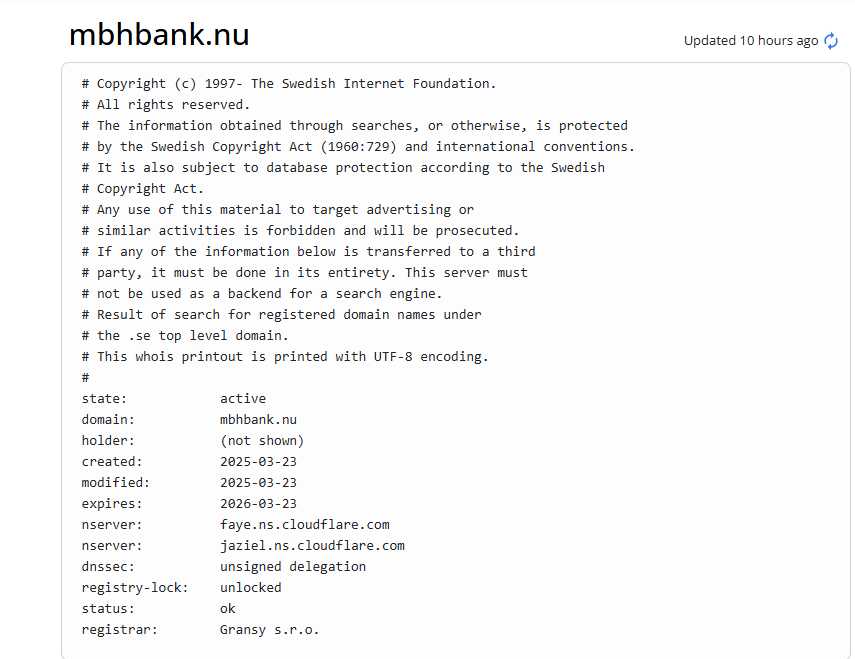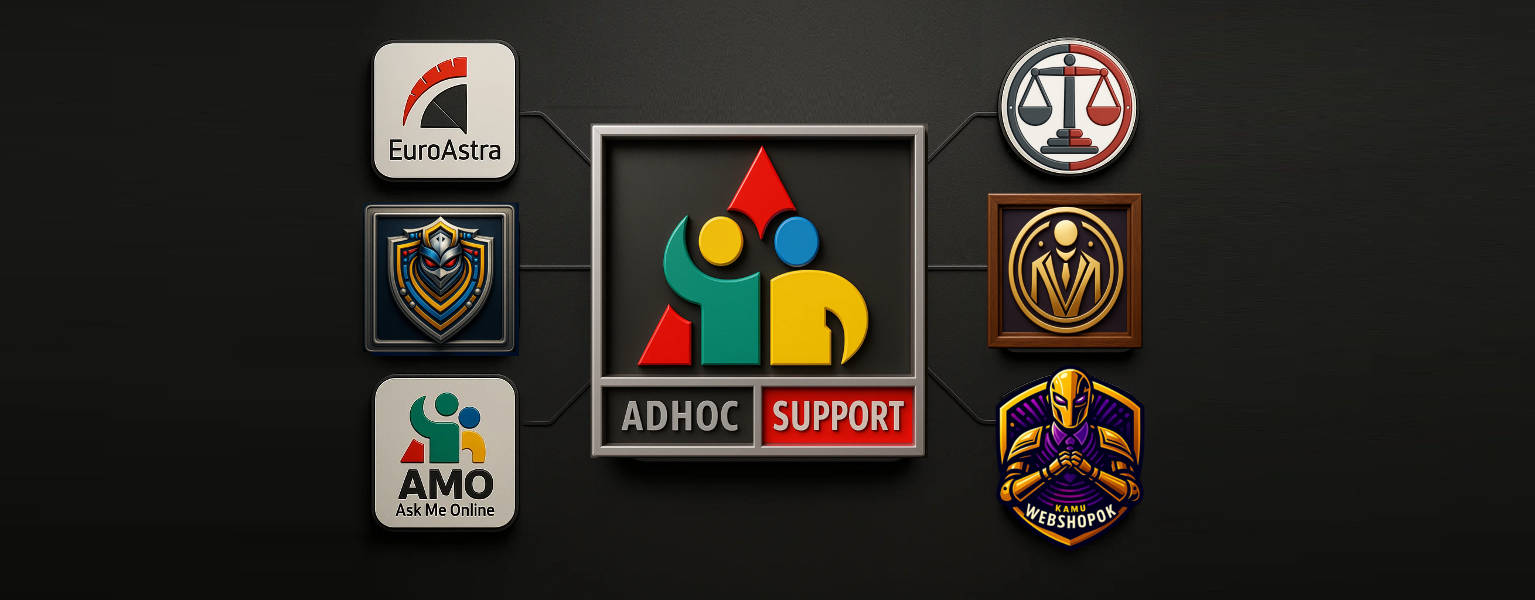
While others failed to react, Adhoc Support took action nine months before the crisis became a national scandal in Hungary. We saw the storm gathering in October 2024 when the online victim support group had between 134 and 334 members. Today, that Facebook community has grown to over 2,500. This is the story of how we identified a threat, built a community, and fought back.
How We Built a Community and Achieved Results for the MBH Victims
From a handful of desperate people, we built a proactive community capable of action, entered into negotiations with a major bank, and helped prevent thousands of further fraudulent attacks. This story perfectly demonstrates the power of the Adhoc Support ecosystem: media amplifies the voice, the community platform organises the power, and education prevents future harm, creating a complex, society-level solution to a serious problem.
1. The Situation: Despair and Isolation
The process began in late 2024 and early 2025 with a handful of desperate individuals. As customers of MBH Bank, they had fallen victim to sophisticated phishing attacks involving phone calls and text messages (the so-called “Google Fraud”), during which scammers siphoned significant sums, often amounting to thousands of pounds, from their accounts.
The victims were left on their own. The bank’s initial response was typically to deflect responsibility by citing customer error, while official investigations by authorities proved to be slow and bureaucratic. The feeling of isolation and powerlessness was overwhelming. They felt that, as individuals, they stood no chance against such a large institution.
2. The Strategy: A Two-Front Attack on Powerlessness
Adhoc Support and its strategic media partner, the online magazine EuroAstra.hu, launched a mutually reinforcing, two-front strategy to find a solution:
-
- The Power of Publicity (The Role of EuroAstra.hu): EuroAstra provided a platform to share the stories and evidence of the first victims. The articles broke the silence and elevated the issue from individual misfortune to a systemic, society-wide problem. This media presence was the “signal flare” that attracted other victims and showed them they were not alone.
- Organising the Community (The Role of Adhoc Support CIC): Building on the media attention, we created a community group for the victims, which functioned as a digital command centre and sanctuary. Here, the victims:
- Recognised they were not alone, which provided immediate psychological support.
- Could share the scammers’ exact methods and their experiences in communicating with the bank and authorities.
- Could gather information and evidence in a structured format under our expert guidance, creating a unified database from their isolated cases.
3. The Result: Critical Mass and Real-World Impact
-
- Mobilisation: From an initial group of a few dozen despairing individuals, we created a proactive advocacy community of over 2,500 members. This critical mass became an unignorable force.
- Effective Advocacy: The sheer number of clients defrauded using the identical method proved incontrovertibly that this was not a series of isolated customer mistakes, but a coordinated, systemic wave of attacks. This pressure forced the bank to revise its communications and approach, and significantly accelerated official investigations by the Hungarian National Bank (MNB) and the National Police.
- Education and Prevention (The Most Important Result): Through continuous and widespread media coverage and the real-time information shared in the community, our prevention campaign reached tens of thousands of MBH customers, saving countless people from financial loss.
The Best Fight is the One You Don’t Have to Have
Many people came to know the names Adhoc Support and EuroAstra.hu in connection with the large-scale fraud series affecting MBH Bank customers. Our joint work proved that community solidarity, investigative journalism, and brave communication can break down walls and achieve results on a national level. We showed how a series of individual, hopeless-seeming complaints can be forged into a single, unignorable common cause.
That fight was about mitigating damages that had already occurred and uncovering the truth. But what about the damages that never happen? What is our loudest victory? It is the one nobody hears about, because we managed to stifle the problem at its root.
This was precisely the goal of the more than 40 educational and preventative articles we published over that period. Our mission is not just to put out raging fires. Our long-term goal is to strengthen our community’s “digital immune system.”
The breakthrough was no accident. It was the result of a deliberately constructed awareness strategy that reached the stimulus threshold of the public and other media outlets, including the staff at major national broadcaster, RTL.
Zsuzsanna Hámori, who was interviewed by RTL for their news report, is herself a member of the Adhoc Support community.
Why Did This Become a National TV News Story? (The Strategic Reasons)
The story gained national traction because our communication successfully transformed the narrative. The issue was no longer about “a few careless people who lost money,” but about the following, much more significant problems:
-
- A Systemic Threat, Not Individual Error: Our articles consistently proved—with concrete cases and detailed descriptions of the scammers’ methods—that these were not isolated user mistakes but a professionally orchestrated, mass attack. When the public understood that anyone could become a victim, the issue transformed from a personal problem into a public affair.
- Institutional Inaction and Responsibility: The series of articles sharply criticised the large corporations involved. It pointed out that MBH Bank was slow to react and initially deflected responsibility. It also questioned Google’s role in allowing deceptive, paid advertising to run. This “David vs. Goliath(s)” narrative is extremely compelling for the media.
- Grassroots Organising as News: The most important factor was that the story had a positive, active hero: the community itself, organised by Adhoc Support. The media wasn’t just reporting on a problem, but on an attempted solution. The process of a handful of victims growing into an advocacy group of thousands is newsworthy in itself. The press and television love stories where “the little guy” bands together to fight back.
How Did We Achieve the Breakthrough? (The Communication Tactics)
Breaking through the public’s indifference was the result of a conscious, phased strategy built on the following tactics:
-
- Starting with Human Stories: The first articles didn’t write about fraud in general terms; they showed the ordeal of specific victims and the concrete, multi-million Forint figures involved. Damages of over £14,000 (6.5 million HUF) were striking enough for others to understand that this wasn’t about losing loose change, but about lives being ruined in minutes by a few clicks. This created an immediate emotional connection with the reader and lent credibility to the story.
- Continuous Publication of Evidence: The articles were filled with screenshots, lists of the fake
.nudomain names, and technical details (e.g., SSL certificate errors, trademark infringement). This signalled to other media outlets that this was a thoroughly researched, fact-based story they could safely pick up. - Community Building as a “Call to Action”: The articles didn’t just present the problem; they offered an active solution: the chance to join the victim community. The writing clearly designated the Adhoc Support platform as the gathering point. This initiated a self-perpetuating cycle: the article brought readers, some readers joined the community, and the growing community gave even greater news value to the next article.
- Keeping it on the Agenda (Building a Series): It was crucial that this wasn’t a one-off story but a numbered series (Part 5, 6, 7, 8…). This maintained interest and created the sense of a live, ongoing, important investigation that was not to be missed.
- Escalating the Narrative: The tone gradually shifted from an empathetic, descriptive style to a tougher, more confrontational one (“The victims speak out – silence is now complicity,” “Why is the bank attacking the victims’ own support groups?”). This dramatic arc increased tension and media interest.
The media picked up the story because our communication strategy built a well-documented, public-interest, self-organising hero story out of a series of individual tragedies. We didn’t just inform; we organised and mobilised the victims, and in doing so, we became the shapers of the news. It was this dynamic and the “little guy fights back” narrative that the mainstream media recognised and amplified.
The websites connected to the scam were promoted with Google ads, often mimicking the real bank’s name and logo. This tactic is nearly identical to the international methods documented by the UK’s leading consumer champion, Which?. One of our key successes was taking direct action to have the fraudulent MBHBANK.NU domain—which hosted a deceptive mock banking login—taken down to protect Hungarian consumers.

The Lesson of This Model
The MBH case is a prime example of how the Adhoc Support model can forge isolated individual complaints into a real social force. We have shown that structured data collection, professional community organising, and strategic media communication working together can achieve results that no single victim would have a chance of reaching on their own.
We don’t just state opinions – we work with facts, data, and the power of community.

Support our community and help us build a fairer world!By supporting us, you’re not just helping yourself, but your family and the future of the whole community. Every donation counts! Support Our Work Here.
